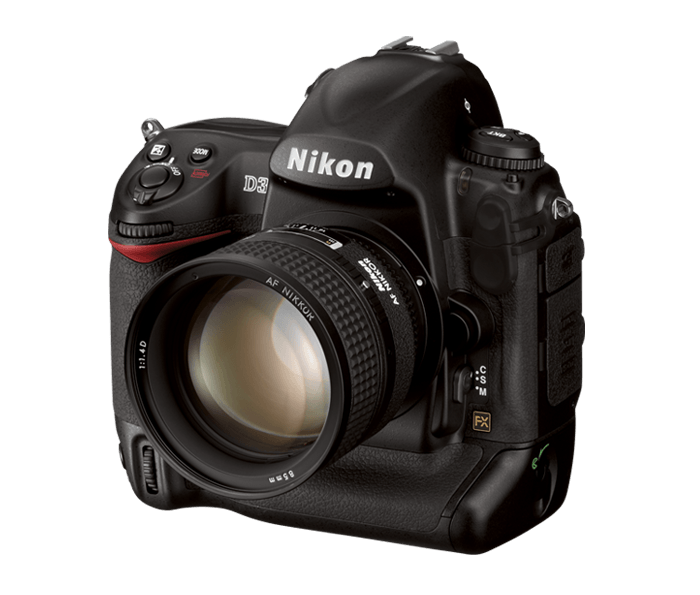Nikon D3 vs D3s Comparison
Nikon D3

Nikon D3s

The Nikon D3 edges out the Nikon D3s by a slight margin, with a score of 58/100 compared to the D3s’s 57/100. Both cameras share the same DSLR type and identical dimensions of 160 x 157 x 88mm. They also have similar announcement dates, with the D3 being released in 2007 and the D3s in 2009.
The Nikon D3 takes the lead with its lower launch price of $4300, compared to the D3s’s $5510. However, the D3s has a slightly lighter weight at 1240g (2.73lbs), making it more comfortable to carry than the D3, which weighs 1300g (2.87lbs).
Considering the minor differences in score and specifications, both cameras offer solid performance. The choice between the two mainly depends on the user’s budget and preference for a lighter camera.
Nikon D3 vs D3s Overview and Optics
The Nikon D3 edges out the Nikon D3s in our optics comparison with a score of 56/100, while the D3s scores 55/100. Both cameras share several key specifications, including 12.1 megapixels, 11 shooting speed, CMOS sensor type, Expeed processor, full-frame sensor size, Nikon F FX lens mount, and no image stabilization.
Despite the minimal difference in scores, the Nikon D3 has a slightly better DXOMARK score for the sensor at 81, compared to the D3s’s score of 82. This means that the D3’s sensor performance is marginally superior, which can contribute to improved image quality in certain situations.
On the other hand, the Nikon D3s does not have any specific advantages in optics over the D3. Both cameras have the same megapixels, shooting speed, sensor type, processor, sensor size, lens mount, and lack of image stabilization. Therefore, the D3s does not outperform the D3 in any optical aspect.
Considering the similarities in specifications and the slight edge in sensor performance for the Nikon D3, it is the winner in this optics comparison. The Nikon D3s does not offer any improvements over the D3 in terms of optics, making the D3 the better choice for those prioritizing optical performance. While the difference in scores is minimal, the D3’s marginally better sensor performance can make a difference in particular situations, and photographers should take this into consideration when choosing between these two cameras.
Nikon D3 vs D3s Video Performance
When examining the video capabilities of the Nikon D3 and Nikon D3s, it is important to note that both cameras do not have video functionality. Therefore, there is no difference between these two models in terms of video capabilities.
Nikon D3 vs D3s Features and Benefits
When comparing the Nikon D3 and the Nikon D3s, it is clear that both cameras have the same feature score of 54/100. This means that neither camera is significantly better than the other in terms of features. However, there are some differences and similarities between the two cameras that are worth noting.
Both the Nikon D3 and the Nikon D3s share several common features, such as a 3-inch screen size, no touchscreen, no flip screen, no GPS, no WIFI, and no Bluetooth. In terms of screen resolution, the Nikon D3 has a slightly higher resolution at 922,000 dots, while the Nikon D3s has 921,000 dots. This difference is minimal and does not impact the overall performance of the cameras significantly.
There are no specific areas where the Nikon D3s is better than the Nikon D3, as both cameras have the same feature score and similar specifications. Similarly, there are no specific areas where the Nikon D3 is better than the Nikon D3s, aside from the slightly higher screen resolution.
Considering the similarities and minimal differences between the Nikon D3 and the Nikon D3s, it is evident that both cameras are comparable in terms of features. The choice between the two cameras ultimately comes down to personal preference and whether the slightly higher screen resolution of the Nikon D3 is important to the user. However, it should be noted that the identical feature score of 54/100 for both cameras indicates that neither camera is significantly better than the other in terms of features, and potential buyers should consider other factors, such as price and availability, when making their decision.
Nikon D3 vs D3s Storage and Battery
The Nikon D3 and Nikon D3s both have a storage and battery score of 87/100, showing no difference in this aspect. They share common features such as having two memory card slots, accepting Compact Flash cards (Type I or II for the D3 and Type I and UDMA for the D3s), and using the same battery type, EN-EL4a. Neither camera has USB charging capabilities.
The Nikon D3 has a slightly longer battery life, providing 4300 shots compared to the D3s’s 4200 shots. This advantage makes the D3 more suitable for extended shooting sessions without the need for frequent battery changes.
On the other hand, the Nikon D3s accepts UDMA memory cards in addition to CompactFlash Type I cards, offering faster data transfer speeds and potentially improving performance in continuous shooting and video recording.
Despite these minor differences, both cameras are evenly matched in terms of storage and battery capabilities. The Nikon D3’s longer battery life and the D3s’s compatibility with UDMA cards cater to different preferences and shooting situations, but neither camera significantly outperforms the other in this area.
Nikon D3 vs D3s – Our Verdict
Are you still undecided about which camera is right for you? Have a look at these popular comparisons that feature the Nikon D3 or the Nikon D3s:

